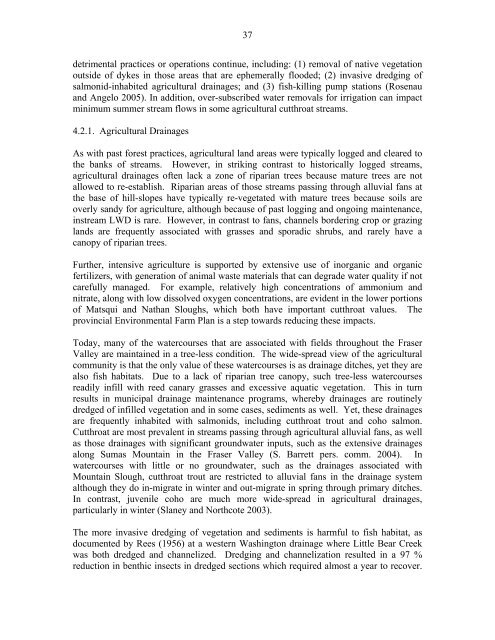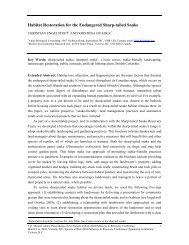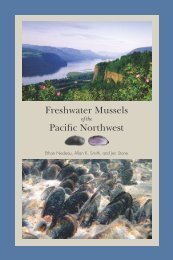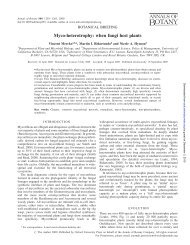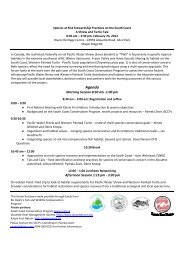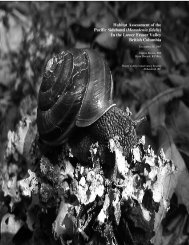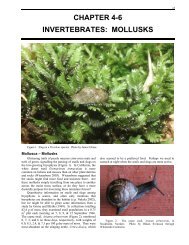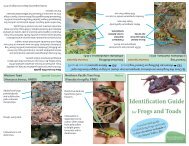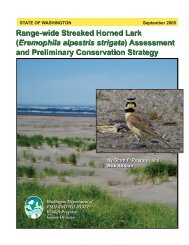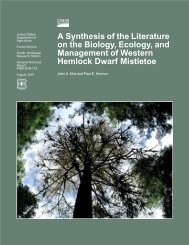Coastal Cutthroat Trout as Sentinels of Lower Mainland Watershed ...
Coastal Cutthroat Trout as Sentinels of Lower Mainland Watershed ...
Coastal Cutthroat Trout as Sentinels of Lower Mainland Watershed ...
Create successful ePaper yourself
Turn your PDF publications into a flip-book with our unique Google optimized e-Paper software.
37detrimental practices or operations continue, including: (1) removal <strong>of</strong> native vegetationoutside <strong>of</strong> dykes in those are<strong>as</strong> that are ephemerally flooded; (2) inv<strong>as</strong>ive dredging <strong>of</strong>salmonid-inhabited agricultural drainages; and (3) fish-killing pump stations (Rosenauand Angelo 2005). In addition, over-subscribed water removals for irrigation can impactminimum summer stream flows in some agricultural cutthroat streams.4.2.1. Agricultural DrainagesAs with p<strong>as</strong>t forest practices, agricultural land are<strong>as</strong> were typically logged and cleared tothe banks <strong>of</strong> streams. However, in striking contr<strong>as</strong>t to historically logged streams,agricultural drainages <strong>of</strong>ten lack a zone <strong>of</strong> riparian trees because mature trees are notallowed to re-establish. Riparian are<strong>as</strong> <strong>of</strong> those streams p<strong>as</strong>sing through alluvial fans atthe b<strong>as</strong>e <strong>of</strong> hill-slopes have typically re-vegetated with mature trees because soils areoverly sandy for agriculture, although because <strong>of</strong> p<strong>as</strong>t logging and ongoing maintenance,instream LWD is rare. However, in contr<strong>as</strong>t to fans, channels bordering crop or grazinglands are frequently <strong>as</strong>sociated with gr<strong>as</strong>ses and sporadic shrubs, and rarely have acanopy <strong>of</strong> riparian trees.Further, intensive agriculture is supported by extensive use <strong>of</strong> inorganic and organicfertilizers, with generation <strong>of</strong> animal w<strong>as</strong>te materials that can degrade water quality if notcarefully managed. For example, relatively high concentrations <strong>of</strong> ammonium andnitrate, along with low dissolved oxygen concentrations, are evident in the lower portions<strong>of</strong> Matsqui and Nathan Sloughs, which both have important cutthroat values. Theprovincial Environmental Farm Plan is a step towards reducing these impacts.Today, many <strong>of</strong> the watercourses that are <strong>as</strong>sociated with fields throughout the Fr<strong>as</strong>erValley are maintained in a tree-less condition. The wide-spread view <strong>of</strong> the agriculturalcommunity is that the only value <strong>of</strong> these watercourses is <strong>as</strong> drainage ditches, yet they arealso fish habitats. Due to a lack <strong>of</strong> riparian tree canopy, such tree-less watercoursesreadily infill with reed canary gr<strong>as</strong>ses and excessive aquatic vegetation. This in turnresults in municipal drainage maintenance programs, whereby drainages are routinelydredged <strong>of</strong> infilled vegetation and in some c<strong>as</strong>es, sediments <strong>as</strong> well. Yet, these drainagesare frequently inhabited with salmonids, including cutthroat trout and coho salmon.<strong>Cutthroat</strong> are most prevalent in streams p<strong>as</strong>sing through agricultural alluvial fans, <strong>as</strong> well<strong>as</strong> those drainages with significant groundwater inputs, such <strong>as</strong> the extensive drainagesalong Sum<strong>as</strong> Mountain in the Fr<strong>as</strong>er Valley (S. Barrett pers. comm. 2004). Inwatercourses with little or no groundwater, such <strong>as</strong> the drainages <strong>as</strong>sociated withMountain Slough, cutthroat trout are restricted to alluvial fans in the drainage systemalthough they do in-migrate in winter and out-migrate in spring through primary ditches.In contr<strong>as</strong>t, juvenile coho are much more wide-spread in agricultural drainages,particularly in winter (Slaney and Northcote 2003).The more inv<strong>as</strong>ive dredging <strong>of</strong> vegetation and sediments is harmful to fish habitat, <strong>as</strong>documented by Rees (1956) at a western W<strong>as</strong>hington drainage where Little Bear Creekw<strong>as</strong> both dredged and channelized. Dredging and channelization resulted in a 97 %reduction in benthic insects in dredged sections which required almost a year to recover.


